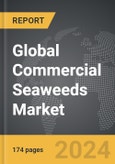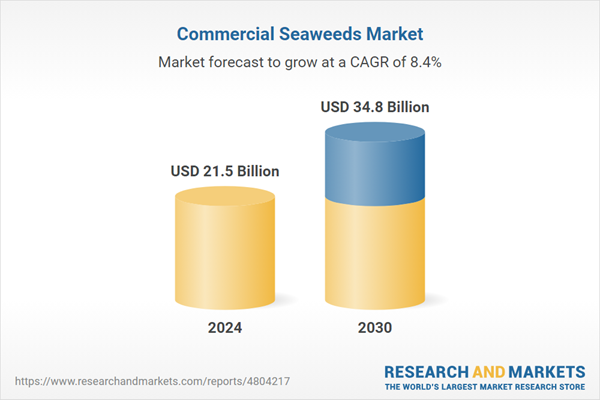The global market for Commercial Seaweeds was valued at US$21.5 Billion in 2024 and is projected to reach US$34.8 Billion by 2030, growing at a CAGR of 8.4% from 2024 to 2030. This comprehensive report provides an in-depth analysis of market trends, drivers, and forecasts, helping you make informed business decisions. The report includes the most recent global tariff developments and how they impact the Commercial Seaweeds market.
Segments: Type (Red, Brown, Green); Form (Liquid, Powdered, Flakes); Application (Human Food, Animal Feed, Agriculture, Other Applications).
Geographic Regions/Countries: World; United States; Canada; Japan; China; Europe (France; Germany; Italy; United Kingdom; Spain; Russia; and Rest of Europe); Asia-Pacific (Australia; India; South Korea; and Rest of Asia-Pacific); Latin America (Argentina; Brazil; Mexico; and Rest of Latin America); Middle East (Iran; Israel; Saudi Arabia; United Arab Emirates; and Rest of Middle East); and Africa.
The analysts continuously track trade developments worldwide, drawing insights from leading global economists and over 200 industry and policy institutions, including think tanks, trade organizations, and national economic advisory bodies. This intelligence is integrated into forecasting models to provide timely, data-driven analysis of emerging risks and opportunities.
Global Commercial Seaweeds Market - Key Trends and Drivers Summarized
How Are Commercial Seaweeds Revolutionizing Sustainable Industries?
Commercial seaweeds are emerging as a vital component in several industries, from food and agriculture to pharmaceuticals and cosmetics, thanks to their sustainable and nutrient-rich properties. Seaweeds, which include various types of marine algae, are cultivated on a large scale to meet the growing global demand for eco-friendly, renewable resources. One of the primary uses of commercial seaweed is in the food industry, where it serves as both a direct food product and a source of additives like agar, carrageenan, and alginate. These compounds are essential in food processing for their gelling, thickening, and stabilizing properties. Beyond food, seaweed’s applications extend into the agricultural sector, where it is used as a biofertilizer to improve soil health and crop yields. Furthermore, the cosmetics industry utilizes seaweed extracts for their hydrating and anti-inflammatory properties in skincare products. As consumers and industries move toward more sustainable practices, the ability of seaweed to sequester carbon and its low environmental impact are becoming critical advantages, making commercial seaweed a key player in the green economy.What Technological Advancements Are Boosting Commercial Seaweed Production?
The commercial seaweed industry has seen a surge in technological innovations aimed at improving cultivation efficiency, yield, and product quality. One of the most significant advancements is the development of automated seaweed farming techniques, which use drones and sensors to monitor water quality, growth rates, and environmental conditions in real-time. These technologies help farmers optimize harvesting times and maximize productivity while minimizing labor costs. Another critical innovation is the use of vertical farming techniques in seaweed aquaculture, which allows for a higher yield per unit area by growing seaweed in stacked layers. This approach is particularly beneficial in regions with limited coastal space, providing a scalable solution for growing demand. Additionally, breakthroughs in bioprocessing have enhanced the extraction of valuable compounds from seaweed, such as polysaccharides and antioxidants, which are used in pharmaceuticals, nutraceuticals, and food products. These technological advancements are not only boosting the economic viability of seaweed farming but are also supporting sustainable practices by reducing resource use and improving the ecological footprint of seaweed production.What Market Trends Are Driving Commercial Seaweed Adoption?
Several market trends are driving the adoption of commercial seaweeds, reflecting shifting consumer preferences and industry needs across multiple sectors. One of the key trends is the growing demand for plant-based and alternative food sources. As consumers become more health-conscious and environmentally aware, seaweed is gaining popularity as a nutrient-dense, sustainable food option. Rich in vitamins, minerals, and antioxidants, seaweed is increasingly used in snacks, supplements, and as a meat or salt substitute. Another major trend is the use of seaweed in agriculture as a natural biofertilizer. With the global push toward reducing synthetic chemical use in farming, seaweed-based fertilizers are being recognized for their ability to enhance soil health, improve water retention, and boost crop resilience to environmental stress. In the pharmaceutical and cosmetic industries, seaweed extracts are in high demand for their bioactive properties, including anti-aging and skin-soothing benefits, driving their use in a variety of beauty and wellness products. Furthermore, as industries look for sustainable alternatives to fossil fuel-based products, seaweed is being explored for use in bioplastics, biofuels, and even animal feed. This expanding market demand highlights the versatility and sustainability of commercial seaweed, making it an increasingly attractive resource for a range of applications.What Factors Are Driving Growth in the Commercial Seaweed Market?
The growth in the commercial seaweed market is driven by several factors linked to technological innovation, environmental sustainability, and increasing demand across various industries. One of the primary drivers is the global shift toward sustainable and eco-friendly practices, as seaweed farming has minimal environmental impact and requires no fertilizers or freshwater, making it a highly sustainable resource. The rising demand for plant-based foods is another major growth driver, as seaweed’s nutritional profile aligns with consumer trends favoring health-conscious and sustainable diets. The food industry’s need for natural additives like carrageenan and agar, derived from seaweed, also continues to grow, particularly in processed foods and alternative dairy products. Technological advancements in seaweed cultivation and processing, such as automated farming systems and efficient extraction techniques, are further fueling market expansion by reducing production costs and improving the scalability of seaweed operations. Additionally, the agriculture sector’s growing use of seaweed-based fertilizers to improve soil health and promote organic farming practices is contributing to increased demand. The pharmaceutical and cosmetics industries are also boosting the market, with seaweed’s bioactive compounds being widely used for their medicinal and skincare benefits. Lastly, the emerging potential of seaweed in biofuel production and as an alternative to single-use plastics is opening new avenues for growth, making commercial seaweed an increasingly integral part of the global green economy.Report Scope
The report analyzes the Commercial Seaweeds market, presented in terms of units. The analysis covers the key segments and geographic regions outlined below.Segments: Type (Red, Brown, Green); Form (Liquid, Powdered, Flakes); Application (Human Food, Animal Feed, Agriculture, Other Applications).
Geographic Regions/Countries: World; United States; Canada; Japan; China; Europe (France; Germany; Italy; United Kingdom; Spain; Russia; and Rest of Europe); Asia-Pacific (Australia; India; South Korea; and Rest of Asia-Pacific); Latin America (Argentina; Brazil; Mexico; and Rest of Latin America); Middle East (Iran; Israel; Saudi Arabia; United Arab Emirates; and Rest of Middle East); and Africa.
Key Insights:
- Market Growth: Understand the significant growth trajectory of the Red Seaweeds segment, which is expected to reach US$18.0 Billion by 2030 with a CAGR of a 8.3%. The Brown Seaweeds segment is also set to grow at 8.8% CAGR over the analysis period.
- Regional Analysis: Gain insights into the U.S. market, valued at $5.8 Billion in 2024, and China, forecasted to grow at an impressive 12.0% CAGR to reach $7.6 Billion by 2030. Discover growth trends in other key regions, including Japan, Canada, Germany, and the Asia-Pacific.
Why You Should Buy This Report:
- Detailed Market Analysis: Access a thorough analysis of the Global Commercial Seaweeds Market, covering all major geographic regions and market segments.
- Competitive Insights: Get an overview of the competitive landscape, including the market presence of major players across different geographies.
- Future Trends and Drivers: Understand the key trends and drivers shaping the future of the Global Commercial Seaweeds Market.
- Actionable Insights: Benefit from actionable insights that can help you identify new revenue opportunities and make strategic business decisions.
Key Questions Answered:
- How is the Global Commercial Seaweeds Market expected to evolve by 2030?
- What are the main drivers and restraints affecting the market?
- Which market segments will grow the most over the forecast period?
- How will market shares for different regions and segments change by 2030?
- Who are the leading players in the market, and what are their prospects?
Report Features:
- Comprehensive Market Data: Independent analysis of annual sales and market forecasts in US$ Million from 2024 to 2030.
- In-Depth Regional Analysis: Detailed insights into key markets, including the U.S., China, Japan, Canada, Europe, Asia-Pacific, Latin America, Middle East, and Africa.
- Company Profiles: Coverage of players such as Acadian Seaplants Limited, Algaia, Biostadt India Limited, Brandt, Cargill, Inc. and more.
- Complimentary Updates: Receive free report updates for one year to keep you informed of the latest market developments.
Some of the 44 companies featured in this Commercial Seaweeds market report include:
- Acadian Seaplants Limited
- Algaia
- Biostadt India Limited
- Brandt
- Cargill, Inc.
- Chase Organics (GB) Ltd.
- Compo GmbH
- CP Kelco
- Dow, Inc.
- DuPont de Nemours, Inc.
- Gelymar
- Indigrow Ltd.
- Leili Agrochemistry Co., Ltd.
- Qingdao Seawin Biotech Group Co., Ltd.
- Roullier Group
- Seasol International Pty. Ltd.
- The Cornish Seaweed Company Ltd
- West Coast Marine Bio-Processing, Corp.
Tariff Impact Analysis: Key Insights for 2025
Global tariff negotiations across 180+ countries are reshaping supply chains, costs, and competitiveness. This report reflects the latest developments as of April 2025 and incorporates forward-looking insights into the market outlook.The analysts continuously track trade developments worldwide, drawing insights from leading global economists and over 200 industry and policy institutions, including think tanks, trade organizations, and national economic advisory bodies. This intelligence is integrated into forecasting models to provide timely, data-driven analysis of emerging risks and opportunities.
What’s Included in This Edition:
- Tariff-adjusted market forecasts by region and segment
- Analysis of cost and supply chain implications by sourcing and trade exposure
- Strategic insights into geographic shifts
Buyers receive a free July 2025 update with:
- Finalized tariff impacts and new trade agreement effects
- Updated projections reflecting global sourcing and cost shifts
- Expanded country-specific coverage across the industry
Table of Contents
I. METHODOLOGYII. EXECUTIVE SUMMARY2. FOCUS ON SELECT PLAYERSIII. MARKET ANALYSISCANADAITALYSPAINRUSSIAREST OF EUROPESOUTH KOREAREST OF ASIA-PACIFICARGENTINABRAZILMEXICOREST OF LATIN AMERICAIRANISRAELSAUDI ARABIAUNITED ARAB EMIRATESREST OF MIDDLE EASTIV. COMPETITION
1. MARKET OVERVIEW
3. MARKET TRENDS & DRIVERS
4. GLOBAL MARKET PERSPECTIVE
UNITED STATES
JAPAN
CHINA
EUROPE
FRANCE
GERMANY
UNITED KINGDOM
ASIA-PACIFIC
AUSTRALIA
INDIA
LATIN AMERICA
MIDDLE EAST
AFRICA
Companies Mentioned (Partial List)
A selection of companies mentioned in this report includes, but is not limited to:
- Acadian Seaplants Limited
- Algaia
- Biostadt India Limited
- Brandt
- Cargill, Inc.
- Chase Organics (GB) Ltd.
- Compo GmbH
- CP Kelco
- Dow, Inc.
- DuPont de Nemours, Inc.
- Gelymar
- Indigrow Ltd.
- Leili Agrochemistry Co., Ltd.
- Qingdao Seawin Biotech Group Co., Ltd.
- Roullier Group
- Seasol International Pty. Ltd.
- The Cornish Seaweed Company Ltd
- West Coast Marine Bio-Processing, Corp.
Table Information
| Report Attribute | Details |
|---|---|
| No. of Pages | 174 |
| Published | April 2025 |
| Forecast Period | 2024 - 2030 |
| Estimated Market Value ( USD | $ 21.5 Billion |
| Forecasted Market Value ( USD | $ 34.8 Billion |
| Compound Annual Growth Rate | 8.4% |
| Regions Covered | Global |









